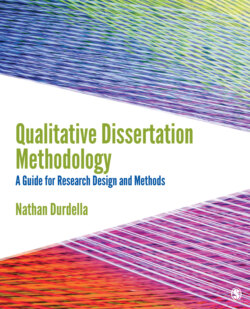Читать книгу Qualitative Dissertation Methodology - Nathan Durdella - Страница 69
На сайте Литреса книга снята с продажи.
Key Questions to Ask Yourself
ОглавлениеWhat does/do my research question(s) and research purpose look like now—wherever I am at in the dissertation stage?
What will my question or questions and purpose look like as I move through my methodology chapter sections?
Working with qualitative research problems, purposes, and questions to inform methodology, researchers generally situate their research design and methods within the broader empirical and conceptual literature. In fact, Sternberg (1981, p. 101) shared an example of how his study’s “methodological design paralleled the theoretical model” presented earlier in the study. If you go immediately to a study’s research questions, you will likely discover how previous research informs them—from the phenomenon to the group and context. Moreover, you will likely find elements of a conceptual framework present in the questions—from terms that may be used or a focus on a specific social phenomenon. Tracing these elements back to the research problem, you will find direct connections to what we still may not know about the topic or do in practice related to the topic—which derive from the review of the empirical literature. On this point, Krathwohl and Smith (2005, p. 76) argue, “The method section should fulfill the expectations created by the foregoing sections.”
The studies that a literature review presents inform the research problem not just in terms of the phenomenon, group, and setting under investigation, but also the methodology that may be used to examine the phenomenon within the group and at the setting. In some cases, researchers adopt the same or similar research methodology that appears in studies in a literature review, while in others the application of a different methodology is appropriate. For instance, if a researcher reproduces a previous study in similar contexts with the same group, she or he will likely need look at the problem from a different methodological lens. Similarly, situating an existing study in a new setting while focusing on the same phenomenon and group and using a similar methodological approach would work equally well. These approaches would qualify as a fresh perspective or novel twist on the existing literature and set up the study to examine the phenomenon in a new way—making a strong contribution to what we know.
A study’s research problem, purpose, and question also generally present a methodological approach to investigate the problem and evaluate the questions. While sometimes more subtle than more direct references to the literature, the focus of a question and terms used in a question often reflect dimensions of a study’s research methodology. For example, the use of the term experiences may point to the use of ethnography in the study’s approach to gathering and making sense of information. Likewise, when a question focuses on interaction, the study may use a phenomenological approach. While you can find a more in-depth discussion of research question–methodology connections in Chapter 3, you can note here that qualitative methodology may be embedded in research questions, purposes, and problems—reflecting decisions about how to collect, analyze, and interpret data.
